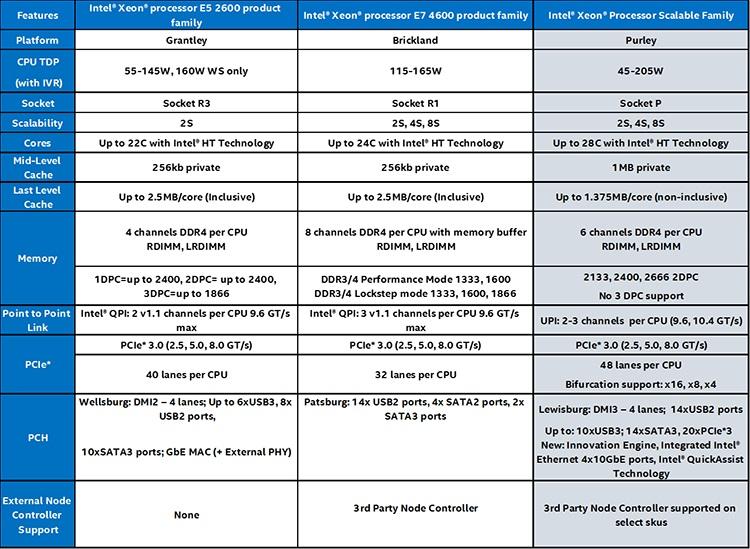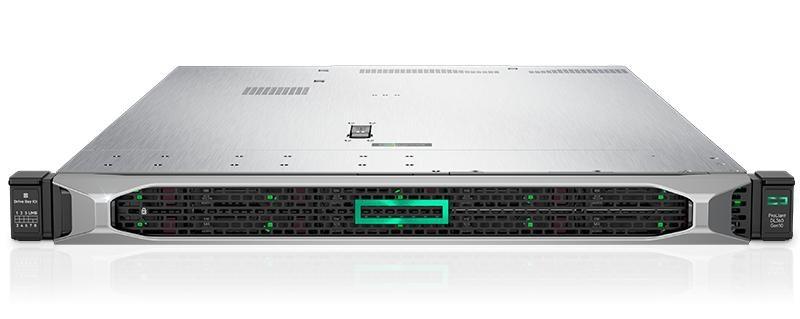Fantastic processors and where they live - the juice from the new lines of HPE, Dell EMC and Lenovo

In the summer of this year, Intel presented a new generation of Intel Xeon Scalable processors , and server manufacturers were quick to add a new product to their updated line. At first glance, in addition to new processors, little has changed. And yet I managed to dig up something interesting in tons of digital waste paper.
In this article I will talk about the curious innovations of HPE ProLiant, Dell EMC PowerEdge and Lenovo ThinkSystem.
First, the main thing - Intel Xeon Scalable
Most of the notable technical innovations in the updated servers are related to the developments of Intel, so I'll start with the processors.
Since 2011, Intel has been presented three lines of processors Xeon - E3, E5 and E7. Each was on its own socket and developed separately. For example, low-cost E3 is now the sixth generation, and high-performance E7 - only the fourth. Therefore, Intel decided to remove the confusion and transferred the processors to a single FCLGA 3647 socket for better scaling.

Comparison of the performance characteristics of Intel Xeon processors of different families. Source: intel.com .
Therefore, the family of processors is called Xeon Scalable, and the usual numbering was replaced by four rulers - Bronze, Silver, Gold and Platinum.

Matching old and new Xeon models.
Of course, the processors were not only called differently, but also acquired a number of interesting features.
I will note the most interesting innovations:
- Intel Volume Management Device (Intel VMD) - allows you to work with NVM Express drives directly, "giving away" the device immediately to the storage system. As a result, full-fledged SSD hot swapping, status indication and use of Intel VROC technology became possible.
- Intel Virtual RAID on CPU (Intel VROC). It allows you to create RAID from NVMe drives using a processor, with it you can abandon software solutions or additional adapters to create arrays of high-speed PCIe SSDs.
- Internet Wide-Area RDMA Protocol (iWARP). The RDMA extension is now supported by Intel's integrated X722 network adapters, because the processor supports four 10-gigabit (or gigabit) Ethernet ports. Let me remind you, RDMA accesses data over the network directly from memory, bypassing the kernel and operating system.
Other innovations concern more security and architectural changes. A more complete list can be found in the material Intel .
Feel the increased power of technology is already on the hardware of all major manufacturers of servers. In addition to the general innovations from Intel, proprietary technologies have also been added there - now let's take a closer look at the new northern generations of the “Big Three”.
HPE ProLiant Gen10
Gen 10 servers are among the first to be sold by HPE. Unfortunately, the new generation of servers has brought a lot of grief and frustration with reworking HPE MicroServer. Now it is assembled on the AMD platform with a decoupled processor and without iLO.
But we will alternate the unpleasant pleasant, so now about the useful innovations.

HPE ProLiant dl360 Gen10 - now with a green frame in the center.
HPE, in terms of processor options, has added almost nothing beyond the standard Intel Xeon Scalable features. There are three new features with the common name Intelligent System Tuning :
- Jitter Smoothing . Smoothing the "jitter" of the processor clock frequency when it is working in Turbo Boost mode. The technology smoothes CPU spikes and reduces memory latency.
- Core Boosting . Even greater overclocking of the processor cores in the Turbo Boost mode in some models of Intel Xeon Scalable 6000 and 8000 families.
- Workload Matching . A set of pre-configured performance profiles depending on the task.
The advantages of the Jitter Smoothing and Core Boosting technologies slightly darken the fact that to activate them you need to buy licenses of iLO Advanced and higher.

Pre-configured performance profiles on HPE ProLiant Gen 10 servers.
Much more interesting new items relating to memory:
- SmartMemory Fast Fault Tolerance (FFT). Predicts errors on areas of memory chips and in advance changes them to spare areas. Analogue of Lockstep from Intel, but less affect performance.
- HPE Scalable Persistent Memory is a HPE NVDIMM-like technology. But NVDIMM is a special non-volatile RAM module in the form of a block device. A Scalable Persistent Memory consists of ordinary DDR4 modules. An excellent RAM disk option for high-performance databases.
In a disk system, you can alternately install different disks: SAS, SATA and NMVe. RAID controllers can also work in mixed mode, combining some disks in a RAID and giving away others as a normal HBA.
In the BMC module, you can now configure RAID and run Intelligent Provisioning directly from the iLO console. Almost all Open IPMI instructions are supported, and the REST API is fully compatible with Redfish standards, which makes management automation even more convenient.
Compared to autumn 2016, prices for iLO editors have changed within the margin of error.
HPE Insight Control is no longer suitable for managing infrastructure with tenth generation servers, so if you have not migrated to HPE OneView 3.0, then it's time to start. The rest of the controls are not much different from what it was before .
Dell EMC PowerEdge 14th Generation
Dell EMC also launched the 14th generation of servers based on Intel Xeon Scalable. There are few unique technical solutions added - the company has focused on automation, control and protection software.

Dell EMC PowerEdge R640.
Of the “many delightful features” of the BMD-module iDRAC 9, I note only the most curious:
- IDRAC module Quick Sync 2 . To manage the server, you can now use not only Android, but also iOS. When installing a new server in the rack, you can also make friends with your favorite smartphone via Wi-Fi or Bluetooth. And then, with a sense of complete superiority, check the hardware configuration of the server and perform basic configuration.
- Trifle, but useful - now the network default settings are set to DHCP.
- Unique iDRAC login password. No more calvin .
- Notifications can also come about SSD wear. Unlike HPE iLO, e-mail notifications are available even in the free version of iDRAC.
- The iDRAC Service Module has moved to iDRAC — there is no need to install additional programs and agents. Fair management without agents: recall the installation of the Agentless Management Service on HPE ProLiant servers.
- All the work of the web interface, including the KVM console, is entirely HTML5. No more Java or .NET, as in HPE iLO.
- All BIOS settings, including RAID management, are now available via the web interface. You do not have to restart the server, frantically pressing F2 in the KVM console.
The entire list of differences between iDRAC versions 8 and 9 can be found in the official document .
Like HPE, in Dell EMC servers, drives with SAS \ SATA and NVMe interfaces can be installed in one basket, but not in all connectors: several universal slots are provided, and the rest remain regular SAS \ SATA.
For ease of automation, the server BIOS configuration can now be exported and imported into good old XML, which simplifies the deployment of new cluster nodes. OpenManage Essentials still works, including with plugins for VMware vCenter, Microsoft System Center and Nagios XI . But in November 2017, a more modern version of the OpenManage Enterprise console should be his replacement.
Lenovo ThinkSystem
It turned out to be a difficult task to get through the jungle of Lenovo documentation in search of innovations of the updated ThinkSystem . After sifting through the marketing of nuggets of information, it turned out a bit, so I share what is.

Lenovo ThinkSystem SR630 - almost unchanged over the years.
Similar to competitors, the built-in control module supports Redfish, IPMI 2.0, and other standards — ready for automation, hyperconvergence, and a different future. Agentless monitoring and HTML5 are also available in the KVM console. But for management and basic configuration from a smartphone, only a USB port is offered.

Now BMC is not called IMM, but XClarity Controller . 3 license options are available for it.
| Standart | Advanced | Enterprise | |
| Power management | + | + | + |
| Event Logs | + | + | + |
| Monitoring | + | + | + |
| Capture a blue screen (OS crash) | + | + | + |
| SNMP | + | + | + |
| Email Notifications | + | + | + |
| Embedded driver packages for deployment | + | + | + |
| Syslog | + | + | |
| KVM | + | + | |
| Remote OS deployment | + | + | |
| Download log | + | ||
| Connecting ISO \ IMG | + | ||
| Collaboration in the console | + | ||
| Power limitation | + | ||
| Price | 0 | $ 50 | $ 100 (upgrade from Advanced - $ 50) |
To monitor and update the firmware, the free Lenovo XClarity Administrator is still used, and for management and automatic deployment, you will need to upgrade it to the Pro version. There are no plug-ins to integrate with VMware vCenter and Microsoft System Center. There is a Lenovo XClarity mobile app for power monitoring and management.
There are several universal connectors for installing NMVe drives. For example, in the ThinkSystem R630 with ten slots for 2.5 ”hard drives, only four are universal.
Elections, Elections
In the best traditions of Top Gear with a specific consumer advice, difficulties have arisen.
HPE servers are traditionally more sophisticated, but more expensive. Dell EMC seems to be a little simpler in terms of patented technologies, but innovations in management already look at the level of HPE, if not more interesting. And with less cost, it makes Dell EMC servers worth buying. We should also note the official plugin for Nagios. Lenovo gives the impression of simple workhorses without any frills.
On the other hand, a new generation of servers, though “faster, higher, stronger” and with a modern design, but old models are enough for ordinary tasks. If you do not need deployment automation and deep support for NVMe drives, then you should consider purchasing a server of the previous generation - for example, the Dell T630 .
')
Source: https://habr.com/ru/post/340808/
All Articles